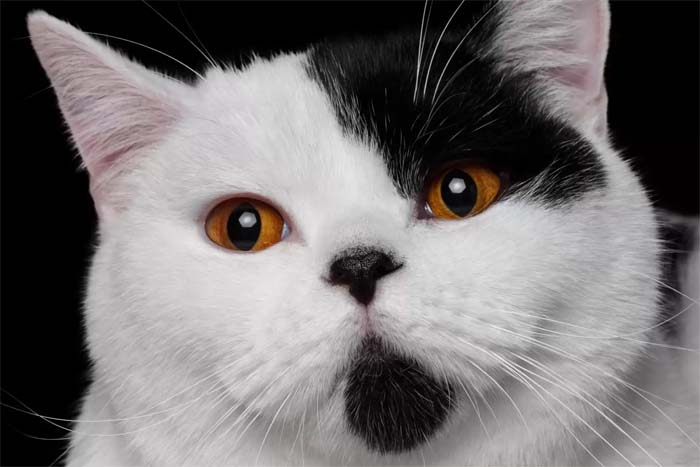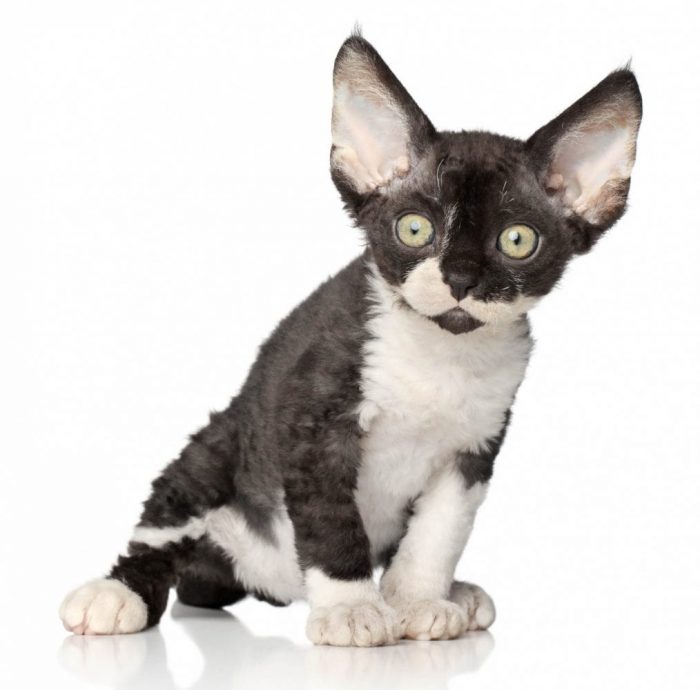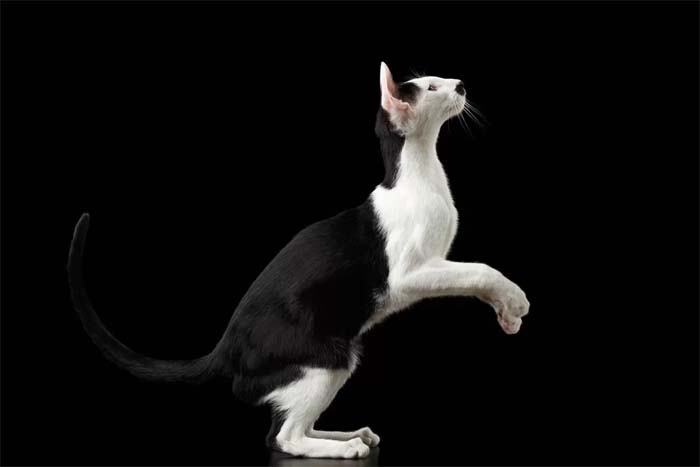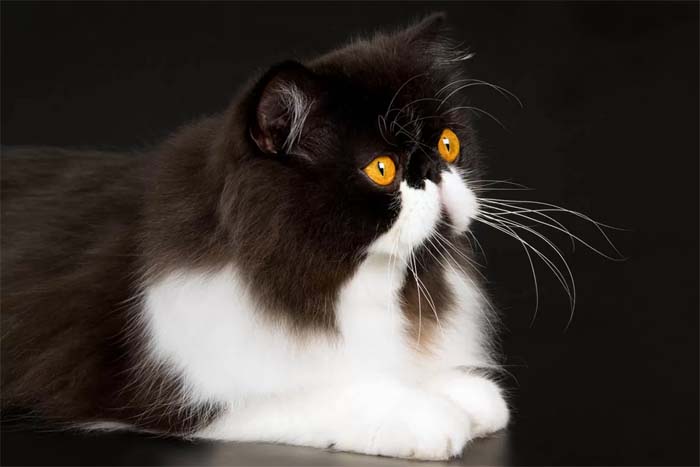Also known as piebald, black and white is a coat combination that consists of solid black with areas of white. The white patches are caused by the white spotting gene which switches off the colour in areas of the body and can affect just a few hairs or be widespread.
The black and white colour is common in both random-bred and purebred cats.
1. British Shorthair

Breed overview
|
About:
Romans introduced cats to the United Kingdom to keep rodent populations down. Father of the cat fancy, Harrison Weir (5 May 1824 – 3 January 1906) is credited with developing these working cats into the breed we now know. British Shorthairs went into sharp decline during WWI but were saved from extinction by outcrossing to Russian Blues and Persians.
Personality:
The British Shorthair is an amiable, quiet and gentle cat who likes to be close to their family but is not overly clingy. Kittens are playful but calm down as they mature into adults. The laid pack personality makes the British Shorthair an ideal companion for seniors and families. If children are too boisterous, the British will take himself away to somewhere quieter. Their independent nature also means that they don’t tend to suffer from separation anxiety if left on their own during the day.
Appearance:
British Shorthairs are a large, cobby breed with a broad chest and strong legs. The large, round head has a good breadth of skull, a short, straight nose and large, well-opened eyes.
2. Cornish Rex

Breed overview
|
About:
The Cornish Rex originated from a tortoiseshell cat named Serena who lived on a farm at Bodmin Moor, Cornwall. Serena gave birth to a litter of kittens, one of whom had an unusual curly coat. Serena’s owner, Nina Ennismore named the kitten Kallibunker (Kalli). Kalli was mated back to his mother, which produced three kittens. Two kittens had the same curly coats. One of these curly-coated kittens died, the second, a male named Poldhu along with Kallibunker went on to found the Cornish Rex breed.
Personality:
The Cornish Rex is an outgoing and active cat often described as the clowns of the cat fancy. Their easygoing and friendly disposition means that they get on well with children and other pets and love to be part of the family. Cornish Rexes love to be up high and will often be found perched on a bookcase or on the shoulders of their favourite human. This playful nature remains well into adulthood.
Appearance:
The Cornish Rex has a long, slim and toned body with long slender legs in proportion to the body. Legs are long and slender with hind legs slightly longer than the forelegs.
The head is small and egg-shaped, with large ears which sit high, a Roman nose and oval eyes.
Cornish Rex cats have a wavy coat, which lacks guard hairs, giving the coat an incredibly soft feel. The wavy coat of the Cornish Rex has been termed Marcel wave, a style popular in the 1920’s.
3. Devon Rex

Breed overview
|
About:
The Devon Rex originated from a single mutation in a stray cat living in an abandoned mine in Buckfastleigh, Devon. This elusive cat mated with a local tortoiseshell and white cat who had befriended local resident Beryl Cox. Four kittens were born at the end of Beryl’s garden, one of whom had the same curly coat as his stray father. Miss Cox named the kitten Kirlee. Kirlee was purchased by Brian Sterling-Webb as it was thought he shared the same gene as the Cornish Rex. However, test matings proved this was not the case and the curly coat was caused by separate genes. Kirlee was used to establish a new breed, named the Devon Rex.
Personality:
The Devon Rex has earned itself the nickname ‘monkey in cat’s clothing‘ which fits the breed perfectly. Devon Rexes are curious, mischievous, active, and playful and have a love of heights. These extremely affectionate cats love nothing more than to be close to their human family and due to their playful nature, get along great with children and other pets.
Because the Devon Rex is an active breed they will benefit from an outlet to burn off some of that energy. They will need lots of opportunities to play with a range of interactive and puzzle cat toys and cat trees or perches to enjoy the world from a height.
Appearance:
The Devon Rex is a small to medium cat with a lithe but muscular body and fine boning. Legs are sturdy and the hind legs are slightly longer than the forelegs. This unique cat breed has an elf-shaped head with prominent cheekbones, large low-set ears and oval eyes set wide apart.
The coat is short, soft and curly and contains all three types of hair guard, awn and down. Whiskers and eyebrows are short and crinkled. All coat colours and patterns are accepted.
4. Exotic Shorthair

Breed overview
|
About:
The Exotic Shorthair is a shorthaired Persian that was created in the 1960s by crossing American Shorthairs with Persians. Burmese and Abyssinian were added to the breeding programme later to introduce new colours and increase the gene pool. Since Exotics are outcrossed to Persians, most litters will contain both short-haired and long-haired kittens.
Personality:
The Exotic Shorthair has a similar placid and laid-back personality to its Persian cousins. With a sweet, affectionate and fun-loving nature, the Exotic is an ideal family pet. Exotics will follow their human family around the home, but they are not as obtrusive or demanding as other breeds.
Appearance:
Exotic Shorthairs are a large, cobby breed with a broad chest and low legs. The head is large and round with a sweet expression. The snub-nose has a break between the large and expressive eyes.
The dense, thick and plush coat comes in all colours and patterns.
5. Oriental Shorthair

Breed overview
|
About:
The Oriental is a close relative of the Siamese cat developed in the United Kingdom. Breeders wanted to create a Siamese-type cat in different coat colours while maintaining the same modern Siamese type head with large ears and a long slender body that tapers to a whiplike tail.
Personality:
Oriental Shorthairs shares similar traits to the Siamese with a friendly, confident, outgoing, highly intelligent, lively, sociable personality. Despite being an active breed, they also love to snuggle on your lap on an evening.
The Oriental makes an ideal family pet who gets along well with children. Some Orientals can form a close attachment to one member of the household although this is less common than with the Siamese.
Appearance:
Oriental cats have a long and tubular body with long, slender legs, oval paws and a long, tapering tail. The head forms an equilateral triangle, with good width between the ears and narrowing to a fine muzzle. The nose should be straight in profile and free from a stop or dip. Ears are large, pricked and wide at the base, continuing the lines of the wedge. Eyes are oriental in shape and slant towards the nose.
6. Persian

Breed overview
|
About:
The Persian is one of the oldest and most popular breeds. Their early history isn’t entirely known although it is generally accepted that the early cats came from Persia (now Iran) and Turkey. Italian traveller Pietro Della Valle (1586 – 1652) is credited with bringing the first Persian cats back to Europe, arriving in his homeland of Italy in 1620 with them.
By the 1800s the Persian had become a popular breed in Europe, and the first Persians arrived in America in the late 1800s. In the Harpers Weekly supplement dated January 27, 1872, there is an illustration of several feline exhibits from the London Crystal Palace show, including a Persian cat.
Harrison Weir, the father of the cat fancy describes the Persian in his book Our Cats and All About Them in which he describes the breeds of cats from the first cat show held at Crystal Palace in 1871.
“This differs somewhat from the Angora, the tail being generally longer, more like a table brush in point of form, and is generally slightly turned upwards, the hair being more full and coarser at the end, while at the base it is somewhat longer. The head is rather larger, with less pointed ears, although these should not be devoid of the tuft at the apex, and also well furnished with long hair within, and of moderate size.”
Personality:
Persian cats are a sweet, placid and laid back breed who generally don’t get themselves into trouble. Due to their affectionate and gentle nature, Persians get along well with children and other pets, unless they are too noisy. They are better able to cope with time on their own, whiling away the hours sleeping in a sunny spot, but do appreciate the company of another cat or dog if their human family is out of the house for extended periods.
Appearance:
Persian cats are a large, robust, cobby breed with short, thick legs with large paws. The legs are short and stocky, and the paws are large and round.
The Persian head is large and broad, with round, expressive eyes that are set wide apart; ears are small and tufted and set low on the head. The nose is short, with a stop (or break) centred between the eyes, and the overall expression is sweet and sometimes described as pansy like.
Some breeders are focusing on breeding Persians who resemble those from the past with less extreme features which are known as Traditional, Doll Face or Old Style Persians.
7. Maine Coon

Breed overview
|
About:
The Maine Coon originated from ship cats brought over on ships from Europe. They were first exhibited at Skowhegan Fair, New England in the 1860s, followed by twelve Maine Coons at the Boston Cat Show in 1878. Cosey, a female Maine Coon won Best in Show at Madison Square Garden in 1895. The Persian cat eclipsed the Maine Coon in the early twentieth century and it was only due to careful and dedicated breeding that the breed was resurrected and remains a popular breed to this day.
Personality:
Maine Coons are an intelligent and loyal breed that thrives on human companionship who are known as the gentle giant of the cat world due to their sweet disposition and calm outlook on life. Their dog-like personality means that Maine Coons love nothing more than to follow their favourite human from room to room.
Activity levels can range from couch potato to energetic, and the Maine Coon loves to be up high. Water is also a favourite, you will never be safe in the bath or shower if you share your home with a Maine Coon.
Appearance:
The Maine Coon is accepted as the largest domestic cat breed that is well-balanced, large and rugged with a broad chest and long, well-muscled body. Tufted ears sit on top of a large and broad head, with wide set eyes and a visibly square chin.
Maine Coons have a silky, shaggy coat with a ruff on the shoulders and a long plumed tail. There is nothing extreme about the Maine Coon apart from its imposing size. It can take up to three years for a Maine Coon to reach maturity.
8. Munchkin

Breed overview
|
About:
The Munchkin breed was developed from a pregnant short-legged cat named Blackberry who was rescued by Kay LaFrance in 1983. Blackberry delivered four kittens, two of whom had the same short legs as their mother. Munchkin cats have achondroplasia, a form of dwarfism which causes a shortening of the long bones. The breed was named after the munchkins from the 1939 movie, The Wizard of Oz. There is some controversy over the welfare of Munchkin cats, and not all cat associations recognise them.
Personality:
Munchkins are energetic, playful and outgoing and maintain their kitten-like personality well into adulthood. Their intelligence means they are easy to train to play fetch or walk with a harness. Munchkins love company and get along well with children, dogs and other cats. Their short-legged stature does not hamper the Munchkin, and they can run and play alongside their long-legged counterparts.
The short legs do not hamper mobility and Munchkin cats will zoom around the house and can jump, although not as high as normal-legged cats. Munchkins have earned the nickname magpie cats due to their love of shiny objects which they love to hide away.
Appearance:
The Munchkin cat is a medium-sized breed with a semi-foreign body, the legs are short with the forelimbs and hindlimbs equal length. Head is a modified wedge, ears are in proportion to the head and round, wide-set eyes.
Munchkins can have a long or short coat, in any colour and pattern combination.
9. Norwegian Forest Cat

Breed overview
|
About:
Affectionately referred to as Wegies or Norsk Skogskatt, the Norwegian Forest Cat is a naturally occurring breed from Northern Europe. Their ancestors are thought to have been brought to the area by Vikings around 1000 AD, and adapted to the harsh winters with a long, water-shedding, woolly.
Crossbreeding with shorthaired cats almost wiped out the Norwegian Forest cat and efforts were made to save the breed, and in 1938, the Norwegian Forest Cat Club was established. However, WWII broke out, and breeding programmes pretty much ground to a halt during this time.
Breeding resumed in earnest in the 1970s and the Norwegian forest cat gained official recognition with the international cat bodies in 1977. The first breeding pair arrived in the United States in 1979. In the 1970s, a cat by the name of Pan’s Truls was to become the benchmark of the Norwegian Forest Cat breed standard. FiFE officially recognised the breed in 1977 and the Cat Fanciers Association in 1987, receiving championship status in 1993.
Personality:
Norwegian Forest cats are easygoing, sweet, mild-mannered and people-loving. These natural athletes regain their kitten like behaviour well into adulthood, and they have exceptional climbing abilities, so a tall cat tree and perches are recommended.
The Norwegian Forest cat can be reserved around strangers, but are affectionate with their human family, unlike some breeds, they don’t play favourites, and love everybody equally.
Appearance:
The Norwegian Forest cat is a slow-growing breed that does not reach full maturity until five years of age. The body is large and well-muscled with substantial bone structure. Legs are medium, and the hind legs are longer than the forelegs. The head is an equilateral triangle, and all sides are equal in length. Ears are medium to large, eyes are large and almond-shaped and the nose profile from the brow ridge is straight, without a break.
The double coat is semi-long, thick and waterproof with a dense, woolly undercoat and smooth guard hairs. Males usually have a thicker coat than females. Top guard hairs are long, glossy and water-resistant, with a dense undercoat. The bib around the neck consists of three sections, with a short collar at the neck, side button chops and a frontal ruff.
Black and white cat genetics
The original wild type (default) colour and pattern brown mackerel tabby. Tabby consists of an agouti base, with alternating pale and dark brown bands, with black fishbone stripes down the body, with tabby markings around the tail, legs and stripes on the face.The black and white colour combination is quite different to the wild type cat described above and is the result of two alleles genes (different versions of a gene). Every cat inherits two copies of each gene, one from the mother and one from the father. A dominant gene needs only one copy for the trait to be expressed while the cat must inherit two copies of a recessive gene. If the gene is dominant, it will be symbolised with an UPPERCASE letter, and recessive genes are symbolised with lowercase letters.
- Solid (non-agouti) – The recessive non-agouti (a) changes the original wild tabby coat into a solid black by overlaying the agouti (ticked) base colour with melanic pigment.
- White spotting – The white spotting (WS) gene is dominant, and causes areas of white on the cat. Cats who are homozygous (inherit two copies of the WS gene) have more widespread areas of white than cats who are heterozygous (inherit one copy of the WS gene). Look at the photo of the Cornish Rex who has much more white than the other cats in the photos.
Feature image: Seregraff/Shutterstock

